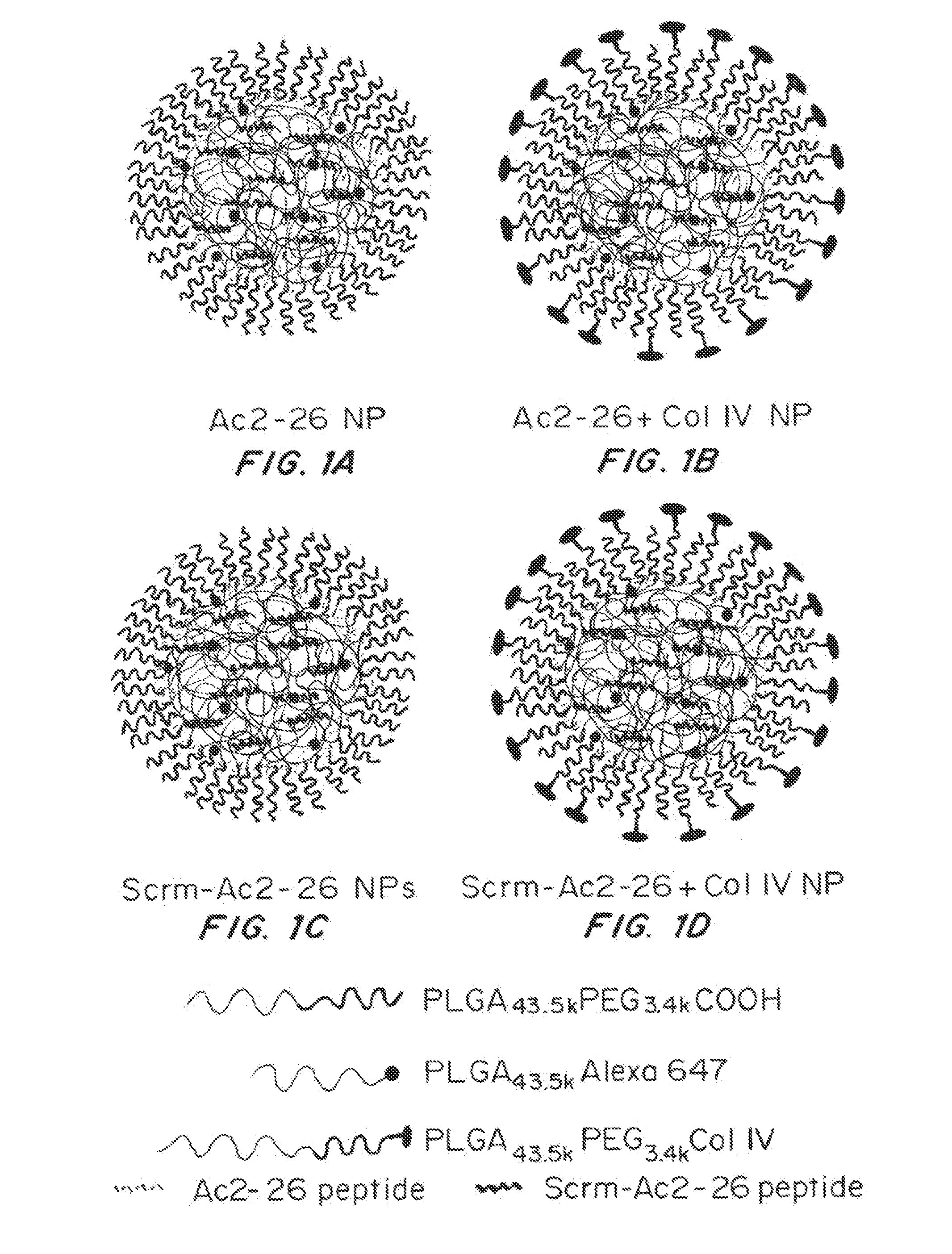Targeted Polymeric Inflammation-Resolving Nanoparticles
- Summary
- Abstract
- Description
- Claims
- Application Information
AI Technical Summary
Benefits of technology
Problems solved by technology
Method used
Image
Examples
example 1
Preparation of Targeted Biodegradable Polymeric NPs Capable of Releasing the Anti-Inflammatory Annexin A1 / Lipocortin A1 Mimetic Peptide Ac2-26
[0117]Ac2-26 was encapsulated in targeted polymeric NPs in order to improve the pharmaceutical and pharmacological properties of Ac2-26 by enhancing its systemic circulation in vivo; site specific delivery; and controlled release in a spatiotemporal manner. A collagen IV (Col IV)-targeted heptapeptide ligand (Chan, et al. Proc Natl Acad Sci USA 107(5):2213-2218 (2010)) was used since Col IV represents 50% of the vascular basement membrane, and it was expected that Col IV exposure will occur at sites of vascular inflammation and injury (Chan et al. Proc Natl Acad Sci USA 107(5):2213-2218 (2010); Kalluri, et al Nature reviews. Cancer 3(6):422-433 (2003)), enabling targeting of the NPs to sites of vascular injury.
[0118]Materials and Methods.
[0119]Materials
[0120]Ac2-26 peptide was purchased from Tocris Biosciences (Bristol, UK). Zymosan A was purc...
example 2
Blockade of Zymosan-Stimulated Polymorphonuclear (PMN) Leucocyte Recruitment in an Acute Peritonitis Model
[0157]A model of self-limited peritonitis was used to quantitatively assess resolution in vivo to determine whether the developed NPs containing Ac2-26 are anti-inflammatory and / or pro-resolving (Bannenberg 2005; Schwab 2007). Zymosan A was administered to C57BL / 6J mice. In parallel, mice were then given vehicle, empty NPs as control, Ac2-26 in NPs, Scrm Ac2-26 in NPs, Ac2-26 native peptides described in detail below. Equal polymer concentration was loaded in both the NPs and Ac2-26 NPs.
[0158]Materials and Methods
[0159]NPs were prepared as described in Example 1.
[0160]In Vivo Murine Peritonitis.
[0161]1 ml of zymosan A (100 μg / mouse) in 1 ml of sterile saline was administered to female C57BL / 6J mice (6-8 wk old, Charles River Laboratories, Wilmington, Mass., USA) to induce peritonitis (Bannenberg et al. J Immunol 174(7):4345-4355 (2005); Norling, et al. (2011) J Immunol 186(10):5...
example 3
Reduction of Ischemia Reperfusion Injury
[0173]Excessive accumulation of PMN within tissues can lead to tissue damage, amplification and prolongation of the inflammatory response (Majno & Joris, Cells, tissues, and disease: principles of general pathology (Oxford University Press, New York) 2nd Ed pp xxviii, 1005 (2004)). Since Ac2-26 NPs limits PMN infiltration in vivo the actions of Ac2-26 NPs in a model of tissue injury driven by excessive PMN infiltration and activation was examined (Qiu et al. Proc Natl Acad Sci USA 97(8):4267-4272).
[0174]Col IV is abundant in basement membranes and is exposed upon injury. It was hypothesized that the targeted NPs would home to the site of injury and release Ac2-26 more efficiently than the non-targeted NPs.
[0175]Materials and Methods
[0176]NPs were prepared as described in example 1.
[0177]Hind-Limb Ischemia Reperfusion Injury.
[0178]Hind-limb ischemia was induced by placing a tourniquet around the hind limb for 1 h, as described by Qiu, et al., P...
PUM
| Property | Measurement | Unit |
|---|---|---|
| Length | aaaaa | aaaaa |
| Electrical conductance | aaaaa | aaaaa |
| Weight ratio | aaaaa | aaaaa |
Abstract
Description
Claims
Application Information
 Login to View More
Login to View More - R&D
- Intellectual Property
- Life Sciences
- Materials
- Tech Scout
- Unparalleled Data Quality
- Higher Quality Content
- 60% Fewer Hallucinations
Browse by: Latest US Patents, China's latest patents, Technical Efficacy Thesaurus, Application Domain, Technology Topic, Popular Technical Reports.
© 2025 PatSnap. All rights reserved.Legal|Privacy policy|Modern Slavery Act Transparency Statement|Sitemap|About US| Contact US: help@patsnap.com



